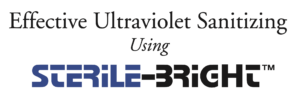
Ultraviolet light in the proper wavelengths destroys pathogens like bacteria, viruses, and fungi. Sterile- BrightTM technology uses a unique combination of germicidal wavelengths—especially Vacuum UV—in conjunction with ozone generation to provide a holistic, comprehensive and reliable sanitizing process. Although UV sanitizing has been well-established for more than 100 years, actual practices (protocols) for using UV for large areas and multiple surfaces is relatively new and often misunderstood. For example, some potential users are concerned about possible adverse effects upon people, pets, plants, and materials. These common questions and concerns will be addressed to provide an understanding of how and why Sterile-BrightTM technology works safely and more effectively than other UV products.
What is Vacuum Ultra Violet Light?
There are several names given to wavelengths below the Ultra Violet. However, because of the absorption of the air down to few nanometers, and the need to evacuate any part of the environmental experiment, this spectral range is called Vacuum Ultra Violet (VUV).

The VUV regions are surrounded by “above” the ultraviolet (UV) spectral region (from 200 nm) and the long wavelength side of the Hard X-Ray region below (around 1 nm).
Three main regions make up the Vacuum Ultra Violet domain:
- The Far Ultra Violet (FUV): 200-120 nm
- The Extreme Ultra Violet (EUV): 120-10 nm
- The Soft X-Rays (Soft X): 15-0.2 nm
These domains have their own physical meanings:
The Far UV ending at around 120 nm, corresponds to the natural barrier of the transmittance of radiation through any window material. The poor reflectivity of optics in soft X-Rays requires the use of large deviation angles up to 170° (extremely low grazing angles).
Vacuum range
Low (rough) vacuum Atmospheric pressure to 1 mbar
Medium vacuum 1 to 10-3 mbar
High vacuum (HV) 10-3 to 10-8 mbar
Ultrahigh vacuum (UHV) 10-8 to 10-12 mbar
Extreme High vacuum (EHV) Less than 10-12 mbar
Source:
WHITE PAPERS
Ultra-Tech’s ‘Sterile-Bright‘ PowerPoint presentation (embedded):
INDEPENDENT THIRD PARTY TEST RESULTS:


READ the full test reports HERE:
Titanium and Ultra-Tech Lighting with its Sterile-Bright™ technology provide the ideal platform for UV-C light and ozone sterilization. Titanium is a distributed cloud-based internet of things (IoT) platform with multi-location, multi-region capabilities. It is a complete, end-to-end platform for monitoring, control, analytics, and savings. Titanium is interoperable and strategically scalable for enterprise solutions.







Disclaimer:
The use of ozone and/or UV should only be used to disinfect areas under the supervision of professionals and only in areas when no one is around. Inhaling ozone can be dangerous and fatal. Ozone should never be used as treatments for humans to inhale, drink or get injected either by IV or IM protocols. These are not approved medical protocols and can be lethal.

https://www.cdc.gov/niosh/idlh/10028156.html
Scientific literature:
1. Inactivation of Surface Viruses by Gaseous Ozone, by Chunchieh Tseng et al. J Environ Health. 2008 Jun.
https://pubmed.ncbi.nlm.nih.gov/18561570/
2. Ozone Inactivation of Norovirus Surrogates on Fresh Produce, by K A Hirneisen et al. J Food Prot. 2011 May.
https://pubmed.ncbi.nlm.nih.gov/21549058/
3. Elimination by Ozone of Shigella Sonnei in Shredded Lettuce and Water, by María Victoria Selma et al. Food Microbiol. 2007 Aug.
https://pubmed.ncbi.nlm.nih.gov/17367682/
4. Inactivation of Foodborne Bacteria Biofilms by Aqueous and Gaseous Ozone, by Marilena Marino et al. Front Microbiol. 2018.
https://pubmed.ncbi.nlm.nih.gov/30210486/
5. Reduction by Gaseous Ozone of Salmonella and Microbial Flora Associated With Fresh-Cut Cantaloupe, by María Victoria Selma et al. Food Microbiol. 2008 Jun.
https://pubmed.ncbi.nlm.nih.gov/18456110/
6. Effect of Gaseous Ozone and Hot Water on Microbial and Sensory Quality of Cantaloupe and Potential Transference of Escherichia Coli O157:H7 During Cutting, by María V Selma et al. Food Microbiol. 2008 Feb.
https://pubmed.ncbi.nlm.nih.gov/17993390/
7. Inactivation of Escherichia Coli O157:H7 by Ozone in Different Substrates, by Stefania Marcia de Oliveira Souza et al. Braz J Microbiol. 2019 Jan.
https://pubmed.ncbi.nlm.nih.gov/30637637/
8. Inactivation of Escherichia Coli O157:H7 and Natural Microbiota on Spinach Leaves Using Gaseous Ozone During Vacuum Cooling and Simulated Transportation, by Mustafa Vurma et al. J Food Prot. 2009 Jul.
https://pubmed.ncbi.nlm.nih.gov/19681283/
9. Ozone and Its Current and Future Application in the Food Industry, by Jin-Gab Kim et al. Adv Food Nutr Res. 2003.
https://pubmed.ncbi.nlm.nih.gov/12402681/
10. Evaluation of Antifungal Effect of Gaseous Ozone in a Meat Processing Plant, by Lisa Vallone et al. Ital J Food Saf. 2014.
https://pubmed.ncbi.nlm.nih.gov/27800339/
11. Sterilization With Ozone in Health Care: An Integrative Literature Review, by Cristina Silva Sousa et al. Rev Esc Enferm USP. 2011 Oct.
https://pubmed.ncbi.nlm.nih.gov/22031389/?from_term=ozone+sterilization&from_pos=1
12. Water and Air Ozone Treatment as an Alternative Sanitizing Technology, by M Martinelli et al. J Prev Med Hyg. 2017 Mar.
https://pubmed.ncbi.nlm.nih.gov/28515631/?from_term=ozone+sterilization&from_pos=9
13. Ozone Inactivation of Norovirus Surrogates on Fresh Produce, by K A Hirneisen et al. J Food Prot. 2011 May.
https://pubmed.ncbi.nlm.nih.gov/21549058/
14. How to Reduce the Likelihood of coronavirus-19 (CoV-19 or SARS-CoV-2) Infection and Lung Inflammation Mediated by IL-1, by P Conti et al. J Biol Regul Homeost Agents. 2020.
https://pubmed.ncbi.nlm.nih.gov/32228825/?from_term=Coronavirus+and+ozone&from_pos=3
15. Potential Mechanisms by Which the Oxygen-Ozone (O2-O3) Therapy Could Contribute to the Treatment Against the Coronavirus COVID-19, by L Valdenassi et al. Eur Rev Med Pharmacol Sci. 2020 Apr.
https://pubmed.ncbi.nlm.nih.gov/32374009/?from_term=Coronavirus+and+ozone&from_pos=6
16. Potential Cytoprotective Activity of Ozone Therapy in SARS-CoV-2/COVID-19, by Gregorio Martínez-Sánchez et al. Antioxidants (Basel). 2020.
https://pubmed.ncbi.nlm.nih.gov/32384798/?from_term=Coronavirus+and+ozone&from_pos=8
17. On Airborne Transmission and Control of SARS-Cov-2, by Maosheng Yao et al. Sci Total Environ. 2020.
https://pubmed.ncbi.nlm.nih.gov/32388162/?from_term=Coronavirus+and+ozone&from_pos=9
18. Environmental Cleanup and Disinfection: The researchers are currently evaluating the use of ultraviolet (UV), ozone, and steam as solutions for large-scale disinfecting needs.
https://www.epa.gov/newsreleases/epa-expands-research-covid-19-environment
19. Oxygen-Ozone as Adjuvant Treatment in Early Control of COVID-19 Progression and Modulation of the Gut Microbial Flora (PROBIOZOVID
https://clinicaltrials.gov/ct2/show/NCT04366089
20. Fast and easy disinfection of coronavirus-contaminated face masks using ozone gas produced by a dielectric barrier discharge plasma generator, by Jinyeop Lee, Cheolwoo Bong, Pan K. Bae, Abdurhaman T. Abafog, Seung Ho Baek, Yong-Beom Shin
https://www.medrxiv.org/content/10.1101/2020.04.26.20080317v2
21. Ozone vs. Coronavirus: Ozone’s Efficacy as a Virucidal Disinfectant
22. Plausible “Penny” Costing Effective Treatment for Corona Virus – Ozone Therapy, Robert Jay Rowen, MD1,* and Howard Robins, DPM2
23. Quail Systems reports that since ozone has been proven to kill 99.999 percent of pathogens in the air, including SARS Coronavirus and influenzas such as H5N1, researchers anticipate that it may be an important tool in preventing the spread of the Coronavirus Disease 2019 (COVID-19).
24. Ultraviolet LEDs prove effective in eliminating coronavirus from surfaces and, potentially, air and water, April 14, 2020, University of California – Santa Barbara
https://www.sciencedaily.com/releases/2020/04/200414173251.htm
25. AlGaN Deep-Ultraviolet Light-Emitting Diodes Grown on SiC Substrates, by Burhan K. SaifAddin*, Abdullah S. Almogbel, Christian J. Zollner, Feng Wu, Bastien Bonef, Michael Iza, Shuji Nakamura, Steven P. DenBaars, and James S. Speck
https://pubs.acs.org/doi/10.1021/acsphotonics.9b00600
26. Ozone and coronavirus – QNotes
Apr 17, 2020 · Ozone has been shown in multiple studies to be highly effective against the SARS coronavirus, which is closely related to the
https://goqnotes.com/65475/ozone-and-coronavirus/
27. Influence of Catalase and Superoxide Dismutase on Ozone Inactivation of Listeria monocytogenes, by Christopher W. Fisher, et al (2000)
28. Isolation of a Psychrotolerant and UV-C-Resistant Bacterium from Elephant Island, Antarctica with a Highly Thermoactive and Thermostable Catalase, by María T. Monsalves, et al (2019)
29. Effects of Ultraviolet Radiation on the Gram-Positive Marine Bacterium Microbacterium maritypicum, by Patrick Williams, et al (2007)
https://bmcinfectdis.biomedcentral.com/articles/10.1186/s12879-020-4847-
31. Ozone Can Be Used To Destroy The New Coronavirus And Disinfect Areas, Source: Thailand Medical news Feb 05, 2020
32. Ozone therapy-the underlying therapeutical concept and models of efficacy. Erfahrungs Heilkunde. Viebahn-Hansler R. 1991;4:40.
33. Ozone: A powerful weapon to combat COVID-19 outbreak
http://www.china.org.cn/opinion/2020-02/26/content_75747237_4.htm
34. Ozone for Inactivation of Aerosolized Bacteriophages, Chun-Chieh Tseng et al
https://www.tandfonline.com/doi/full/10.1080/02786820600796590

